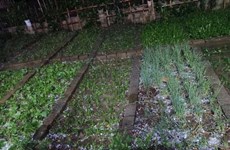Nam Dinh plants mangrove to fight climate change
The Red River Delta province of Nam Dinh is undertaking efforts to
foster mangrove plantation in coastal areas to fight climate change, building on the success ò a mangrove plantation and disaster risk reduction (MP/DRR) programme which has been carried out since 1997 in 15 communes in the coastal of Hai Hau, Giao Thuy, and Nghia Hung.
The Red River Delta province of Nam Dinh is undertaking efforts to
foster mangrove plantation in coastal areas to fight climate change,
building on the success ò a mangrove plantation and disaster risk
reduction (MP/DRR) programme which has been carried out since 1997 in 15
communes in the coastal of Hai Hau, Giao Thuy, and Nghia Hung.
Under that programme - which was funded by the Danish Red Cross between 1997 and 2005 and by the Japanese Red Cross since 2006 - more than 6,500 hectares of mangrove have been planted, contributing to protecting the environment and biodiversity.
According to Vice Chairman of the Nam Dinh Red Cross Pham Minh Phuong, the mangrove plantation has made a significant contribution to protecting the local sea dyke system, preventing and controlling natural disasters and boosting socio-economic development.
The project has benefited more than 2,000 households in Giao An commune, Giao Thuy district, with more than 1,200 hectares of mangrove planted together with nearly 900 hectares of trees.
Chairman of the Giao An Red Cross, Vu Duc Phuong, highlighted the practical benefits from the project to the targeted coastal residential areas over the past 18 years, saying that they have seen a significant change in their defences against high sea waves and stormy winds.
The mangrove forests have also contributed to consolidating the local sea dyke system, thus reducing landslides, erosion, flood tides and embankment breaches.
Nam Dinh is one of the localities most vulnerable to natural disasters during the flood season due to its geographical features. The areas surrounding the Red, Dao, Day and Ninh Co Rivers are particularly prone.
It is one of ten Vietnamese provinces to benefit from the MP/DRR programme. It has developed 91km of sea dykes and more than 300km of river dykes.-VNA
Under that programme - which was funded by the Danish Red Cross between 1997 and 2005 and by the Japanese Red Cross since 2006 - more than 6,500 hectares of mangrove have been planted, contributing to protecting the environment and biodiversity.
According to Vice Chairman of the Nam Dinh Red Cross Pham Minh Phuong, the mangrove plantation has made a significant contribution to protecting the local sea dyke system, preventing and controlling natural disasters and boosting socio-economic development.
The project has benefited more than 2,000 households in Giao An commune, Giao Thuy district, with more than 1,200 hectares of mangrove planted together with nearly 900 hectares of trees.
Chairman of the Giao An Red Cross, Vu Duc Phuong, highlighted the practical benefits from the project to the targeted coastal residential areas over the past 18 years, saying that they have seen a significant change in their defences against high sea waves and stormy winds.
The mangrove forests have also contributed to consolidating the local sea dyke system, thus reducing landslides, erosion, flood tides and embankment breaches.
Nam Dinh is one of the localities most vulnerable to natural disasters during the flood season due to its geographical features. The areas surrounding the Red, Dao, Day and Ninh Co Rivers are particularly prone.
It is one of ten Vietnamese provinces to benefit from the MP/DRR programme. It has developed 91km of sea dykes and more than 300km of river dykes.-VNA












